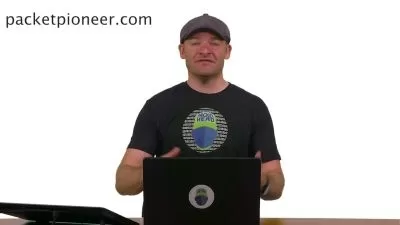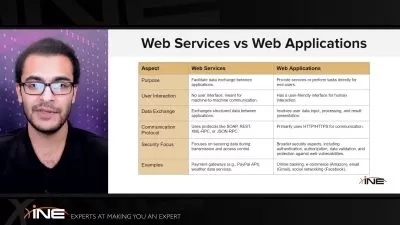Networking | Network Fundamentals, Wireshark & Packet Tracer
Oak Academy
10:36:50
Description
Mastering Networking with Network Fundamentals, Wireshark Network Analysis and Cisco Packet Tracer Network simulations
What You'll Learn?
- CCNA stands for Cisco Certified Network Associate, which is a certification you can earn after taking the 120-minute exam administered by Cisco.
- You can also gain hands-on Cisco CCNA configuration and troubleshooting experience through practice labs.
- The CCNA exam tests your knowledge and skills in networking fundamentals such as routing and switching, network access, IP connectivity, IP services, security.
- Wireshark is one of the most popular network analyzer tools available worldwide for network analysis or troubleshoot network issues
- Cisco Packet Tracer is a visual simulation tool designed by Cisco Systems that allows users to create network topologies and imitate modern computer networks
- Routers, Hubs and Switches in cisco CCNA 200 -301
- Security Features in ccna security
- No Wire - Wireless in cisco CCNA 200 -301
- Servers in ccna security
- Make It Virtual in cisco ccna
- The Great OSI Model in cisco CCNA 200 -301
- What is TCP/IP?
- UDP vs TCP in cisco ccna
- Well-known Network Architectures
- Standard (Copper) Cables
- Fiber Optic Cables in ccna 200-301
- What is IPv4 (ipv4) Address?
- Classes and Assignment of IPv4 (ipv4) Address
- DNS Services in ccna 200-301
- Unicast, Multicast and Broadcast
- Binary Format Numbering in cisco ccna 200-301
- Subnetting
- Subnetting – Subnet Mask in cisco ccna 200-301
- Practice for Subnetting
- Why and What is IPv6 (ipv6) Address?
- IPv6 (ipv6) Address Format
- IPv6 (ipv6) Address Types
- What is Routing and Its Process?
- Metric and Administrative Distance in Routing Tables
- Let’s Compare Routing Protocols in cisco ccna 200-301
- What is OSPF?
- OSPF Adjacency & Neighbor Forming Process
- OSPF Cost in cisco ccna
- OSPF Areas and LSAs
- OSPF Configuration in cisco ccna
- First-Hop Redundancy Protocols
- Routing
- Networking Devices
- The OSI Reference Model
- IPv4 - IPv6
- DHCP Server Configuration
- Basic Packet Tracer Network
- VLAN Virtual LAN Configuration
- NAT Network Address Translation Configuration
- DNS Domain Name System Configuration
- IPv6 Configuration
- ICMP Analysis
- ARP Analysis
- Network Fundamentals
- Packet Captures in Wireshark
- Analyze packets using the Wireshark tool
- Filter network traffic and identify potentially malicious traffic
- Examine the data within the network and how it shows up in Wireshark
- Explore the different methods of setting up a packet capture
- DNS Analysis
Who is this for?
What You Need to Know?
More details
Description
Hello there,
Welcome to “Networking | Network Fundamentals, Wireshark & Packet Tracer†course
Mastering Networking with Network Fundamentals, Wireshark Network Analysis and Cisco Packet Tracer Network simulations
Networking, or computer networking, is the process of connecting two or more computing devices, such as desktop computers, mobile devices, routers or applications, to enable the transmission and exchange of information and resources.
Networked devices rely on communications protocols—rules that describe how to transmit or exchange data across a network—to share information over physical or wireless connections.
Wireshark is a widely used, open source network analyzer that can capture and display real-time details of network traffic. It is particularly useful for troubleshooting network issues, analyzing network protocols and ensuring network security. Networks must be monitored to ensure smooth operations and security.
Wireshark 's main function is to help analyze the traffic on any network of your choice regardless of size.
Cisco Packet Tracer is a comprehensive, networking technology teaching and learning program that offers a unique combination of realistic simulation and visualization experiences, assessment and activity authoring capabilities, and opportunities for multiuser collaboration and competition. The innovative features of Packet Tracer help students and teachers collaborate, solve problems, and learn concepts in an engaging and dynamic social environment.
Packet Tracer is a simulation, visualization, collaboration, and assessment tool for teaching networking.
It allows students to construct their own model or virtual networks, obtain access to important graphical representations of those networks, animate those networks by adding their own data packets, ask questions about those networks, and finally annotate and save their creations.
This course integrates IT Networking Fundamentals, Wireshark, and Cisco Packet Tracer to provide a comprehensive understanding of network security. Learning these topics equips cybersecurity professionals with the knowledge of how networks function, how to identify potential threats, and how to mitigate these threats effectively.
How Will This Course Help Me:
Comprehensive Understanding of Network Security: By covering IT Networking Fundamentals, Wireshark, and Cisco Packet Tracer, this course provides a holistic understanding of network security. You will gain the knowledge needed to identify and mitigate potential security threats effectively.
Practical Skills Development: You will develop practical skills in network traffic analysis, network design, and troubleshooting. This hands-on experience is invaluable for a career in cybersecurity, enabling you to apply what you learn in real-world scenarios.
Enhanced Career Opportunities: Mastering these essential tools and concepts will make you a more competitive candidate in the job market. The skills you acquire in this course are highly sought after by employers in the networking and cybersecurity field.
What Will You Learn In This Course ?
Bases of Networking Technologies,Â
Routers, Hubs and Switches,
TCP/IP,
UDP,
ICMP,
Wireshark
Filtering Captures
Packet Dissection
Packet Navigation
Packet Filtering
Protocol Filters
Networking Devices
Subnetting – Subnet Mask
IPv4 Addressing
IPv6 Addressing
IP Routing
Router Configuration
Wireless Technologies
Sample applied analysis related to the topics and much more...
No prior knowledge is needed!
This course provides a thorough grounding in these critical areas, ensuring you are well-prepared for a successful career in Networking and other related IT fields. Enroll now to gain the knowledge and skills needed to protect and secure network environments effectively. This course is also a very informative and practical course for candidates preparing for the CCNA 200-301 certification exam.
Frequently asked questions
What are the basics of IT networking?
IT networking covers the fundamental concepts of how devices communicate within a network, including IP addressing, subnetting, and network protocols.
What is the meaning of packet capture?
It is the process of intercepting a data packet that is moving through a network. The data packet helps in network analysis that is by analysis the data one can know the security status of the net.
Explain packet sniffers or network analyzers work?
Packet sniffers work by intercepting into a network that they can "see." What a packet sniffer can capture depends on the structure of the net. Ones a packet sniffer or network analyzer captures a packet they analyze it and present it in human readable form so that the user of packet sniffer can make use of the data.
It is wise to note a packet sniffer gets set into two ways. Some can be configured to capture all the data in this way we say they are unfiltered. There are those that are set to capture specific packets. We describe them as filtered.
What is the standard software tool that is used for packet sniffing or network analysis?
The most known network analysis or packet sniffing tool is called WireShark. It was known as Ethereal in the past and gathered datagram in real time have them in a form that you can read. It has color coding, filters, and other great features. It helps you analyze individual data packets and helps you go deeper in network matters.
What is Cisco Packet Tracer used for?
Packet Tracer is a cross-platform visual simulation tool designed by Cisco Systems that allows users to create network topologies and imitate modern computer networks. The software allows users to simulate the configuration of Cisco routers and switches using a simulated command line interface.
How can I obtain Cisco Packet Tracer?
Cisco Packet Tracer is available free of charge to all Cisco Networking Academy instructors, students, and alumni.
Please follow these instructions to download the software from the NetAcad. com learning environment:
Log in to Cisco NetAcad. com
Select Resources > Download Packet Tracer
Are older versions of Cisco Packet Tracer still available?
No, previous versions are no longer supported. You are strongly encouraged to upgrade to the latest version of Cisco Packet Tracer to take advantage of new features, security improvements, and bug fixes.
Can students and instructors install Cisco Packet Tracer on their home computers or personal laptops?
Yes. Cisco Packet Tracer can be freely distributed to any Networking Academy instructor, student, or alumni. This enables students to use Cisco Packet Tracer on any computer outside of class for homework, practice, and exploratory learning.
Why would you want to take this course?
Our answer is simple: The quality of teaching
When you enroll, you will feel our seasoned instructors' expertise
Fresh Content
It’s no secret how technology is advancing at a rapid rate and it’s crucial to stay on top of the latest knowledge. With this course, you will always have a chance to follow the latest data science trends.
Video and Audio Production Quality
All our videos are created/produced as high-quality video and audio to provide you the best learning experience
You will be,
Seeing clearly
Hearing clearly
Moving through the course without distractions
You'll also get:
Lifetime Access to The Course
Fast & Friendly Support in the Q&A section
Udemy Certificate of Completion Ready for Download
Dive in now “Network+ | Comptia Network Plus (N10-008) Certification Prep†course
Who this course is for:
- Anyone interested in network
- Those who have a career goal in the field of network and security
- Those who have a basic knowledge of network and want to take it to higher levels.
- Those who want to step into the world of network and security
- Junior Security elements
- Those who want to step into the world of cybersecurity
Hello there,
Welcome to “Networking | Network Fundamentals, Wireshark & Packet Tracer†course
Mastering Networking with Network Fundamentals, Wireshark Network Analysis and Cisco Packet Tracer Network simulations
Networking, or computer networking, is the process of connecting two or more computing devices, such as desktop computers, mobile devices, routers or applications, to enable the transmission and exchange of information and resources.
Networked devices rely on communications protocols—rules that describe how to transmit or exchange data across a network—to share information over physical or wireless connections.
Wireshark is a widely used, open source network analyzer that can capture and display real-time details of network traffic. It is particularly useful for troubleshooting network issues, analyzing network protocols and ensuring network security. Networks must be monitored to ensure smooth operations and security.
Wireshark 's main function is to help analyze the traffic on any network of your choice regardless of size.
Cisco Packet Tracer is a comprehensive, networking technology teaching and learning program that offers a unique combination of realistic simulation and visualization experiences, assessment and activity authoring capabilities, and opportunities for multiuser collaboration and competition. The innovative features of Packet Tracer help students and teachers collaborate, solve problems, and learn concepts in an engaging and dynamic social environment.
Packet Tracer is a simulation, visualization, collaboration, and assessment tool for teaching networking.
It allows students to construct their own model or virtual networks, obtain access to important graphical representations of those networks, animate those networks by adding their own data packets, ask questions about those networks, and finally annotate and save their creations.
This course integrates IT Networking Fundamentals, Wireshark, and Cisco Packet Tracer to provide a comprehensive understanding of network security. Learning these topics equips cybersecurity professionals with the knowledge of how networks function, how to identify potential threats, and how to mitigate these threats effectively.
How Will This Course Help Me:
Comprehensive Understanding of Network Security: By covering IT Networking Fundamentals, Wireshark, and Cisco Packet Tracer, this course provides a holistic understanding of network security. You will gain the knowledge needed to identify and mitigate potential security threats effectively.
Practical Skills Development: You will develop practical skills in network traffic analysis, network design, and troubleshooting. This hands-on experience is invaluable for a career in cybersecurity, enabling you to apply what you learn in real-world scenarios.
Enhanced Career Opportunities: Mastering these essential tools and concepts will make you a more competitive candidate in the job market. The skills you acquire in this course are highly sought after by employers in the networking and cybersecurity field.
What Will You Learn In This Course ?
Bases of Networking Technologies,Â
Routers, Hubs and Switches,
TCP/IP,
UDP,
ICMP,
Wireshark
Filtering Captures
Packet Dissection
Packet Navigation
Packet Filtering
Protocol Filters
Networking Devices
Subnetting – Subnet Mask
IPv4 Addressing
IPv6 Addressing
IP Routing
Router Configuration
Wireless Technologies
Sample applied analysis related to the topics and much more...
No prior knowledge is needed!
This course provides a thorough grounding in these critical areas, ensuring you are well-prepared for a successful career in Networking and other related IT fields. Enroll now to gain the knowledge and skills needed to protect and secure network environments effectively. This course is also a very informative and practical course for candidates preparing for the CCNA 200-301 certification exam.
Frequently asked questions
What are the basics of IT networking?
IT networking covers the fundamental concepts of how devices communicate within a network, including IP addressing, subnetting, and network protocols.
What is the meaning of packet capture?
It is the process of intercepting a data packet that is moving through a network. The data packet helps in network analysis that is by analysis the data one can know the security status of the net.
Explain packet sniffers or network analyzers work?
Packet sniffers work by intercepting into a network that they can "see." What a packet sniffer can capture depends on the structure of the net. Ones a packet sniffer or network analyzer captures a packet they analyze it and present it in human readable form so that the user of packet sniffer can make use of the data.
It is wise to note a packet sniffer gets set into two ways. Some can be configured to capture all the data in this way we say they are unfiltered. There are those that are set to capture specific packets. We describe them as filtered.
What is the standard software tool that is used for packet sniffing or network analysis?
The most known network analysis or packet sniffing tool is called WireShark. It was known as Ethereal in the past and gathered datagram in real time have them in a form that you can read. It has color coding, filters, and other great features. It helps you analyze individual data packets and helps you go deeper in network matters.
What is Cisco Packet Tracer used for?
Packet Tracer is a cross-platform visual simulation tool designed by Cisco Systems that allows users to create network topologies and imitate modern computer networks. The software allows users to simulate the configuration of Cisco routers and switches using a simulated command line interface.
How can I obtain Cisco Packet Tracer?
Cisco Packet Tracer is available free of charge to all Cisco Networking Academy instructors, students, and alumni.
Please follow these instructions to download the software from the NetAcad. com learning environment:
Log in to Cisco NetAcad. com
Select Resources > Download Packet Tracer
Are older versions of Cisco Packet Tracer still available?
No, previous versions are no longer supported. You are strongly encouraged to upgrade to the latest version of Cisco Packet Tracer to take advantage of new features, security improvements, and bug fixes.
Can students and instructors install Cisco Packet Tracer on their home computers or personal laptops?
Yes. Cisco Packet Tracer can be freely distributed to any Networking Academy instructor, student, or alumni. This enables students to use Cisco Packet Tracer on any computer outside of class for homework, practice, and exploratory learning.
Why would you want to take this course?
Our answer is simple: The quality of teaching
When you enroll, you will feel our seasoned instructors' expertise
Fresh Content
It’s no secret how technology is advancing at a rapid rate and it’s crucial to stay on top of the latest knowledge. With this course, you will always have a chance to follow the latest data science trends.
Video and Audio Production Quality
All our videos are created/produced as high-quality video and audio to provide you the best learning experience
You will be,
Seeing clearly
Hearing clearly
Moving through the course without distractions
You'll also get:
Lifetime Access to The Course
Fast & Friendly Support in the Q&A section
Udemy Certificate of Completion Ready for Download
Dive in now “Network+ | Comptia Network Plus (N10-008) Certification Prep†course
Who this course is for:
- Anyone interested in network
- Those who have a career goal in the field of network and security
- Those who have a basic knowledge of network and want to take it to higher levels.
- Those who want to step into the world of network and security
- Junior Security elements
- Those who want to step into the world of cybersecurity
User Reviews
Rating
Oak Academy
Instructor's Courses
Udemy
View courses Udemy- language english
- Training sessions 89
- duration 10:36:50
- Release Date 2024/10/31









